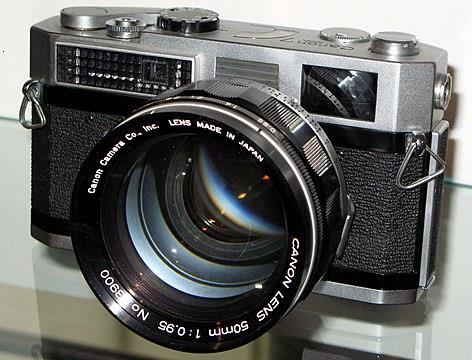
The image above is from Wikimedia Commons, licensed under the Creative Commons Attribution Share-Alike 2.0 License France, and is thus available for your use under the same terms.
Its author is Rama.
I was surprised to learn that the Konica Autoreflex T, which we met on the previous page, had one characteristic usually associated with cheaper cameras from Eastern Europe. The normal lenses available for the camera, instead of having the usual focal length of 50mm, had slightly longer focal lengths.
According to one web site, the choices offered were an f/1.8 lens with a focal length of 52mm, an f/1.4 lens with a focal length of 57mm, and an f/1.2 lens also with a focal length of 57mm.
The mirror in an SLR demands that lenses have a considerable clearance between the back of the lens and the focal point where the image is formed. This complicates lens design, and thus choosing a slightly longer focal length allows making a higher-quality lens at a lower price.
Perhaps the lens I am thinking of is the f/2 lens with a focal length of 58mm; a Biotar lens made by Carl Zeiss Jena had these specs, and so did a Soviet copy, the original Helios-44 lens. Another example of this was also from Carl Zeiss Jena; the Pancolar lens, with an f/1.4 aperture, for Praktica cameras, had a focal length of 55mm. This lens is something of a rare collector's item, as it was made specifically for the Pentacon Super SLR camera. It was first manufactured in 1967. Later on (in 1978), though, the f/1.4 Prakticar-B lens managed the standard 50mm focal length.
Looking at the history of the double-Gauss lens, though, I learned that several major camera manufacturers reached f/1.4 either first or at a budget price with a lens having a 58mm focal length. The Nikon Nikkor-S Auto from 1959, the Minolta Auto-Rokkor PF from 1961, and two versions of the Topcon RE Auto-Topcor from 1963.
And as late as 1971, Canon went to 55mm for its f/1.2 FD AL lens, and in 1972, Olympus' G. Zuiko Auto-S also went to 55mm to achieve f/1.2.
For that matter, Pentax offered their Takumar f/1.8 lens with a focal length of 55mm.
 |
The image above is from Wikimedia Commons, licensed under the Creative Commons Attribution Share-Alike 2.0 License France, and is thus available for your use under the same terms. Its author is Rama. |
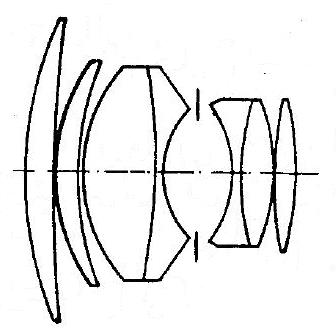
When back focus is not an issue, then more impressive apertures can be achieved. In 1961, Canon brought out an f/0.95 lens with a 50mm focal length for use on its rangefinder cameras, such as the Canon 7; a Canon 7 with this lens is pictured at right, and a diagram of the optical layout of this lens is shown at left. As can be seen from that diagram, it has seven elements in five groups; it has a double-Gauss design not unlike that of many f/1.4 lenses.
This diagram is derived from that in the patent for this lens, U.S. Patent 3,357,776. Interestingly, the lens was not devised in-house by Canon, but by a Dutch firm.
Naturally, some other prestigous camera makers found it necessary to compete. Thus, Leica offered its own 50mm f/0.95 Noctilux-M in 1975, Schneider offered their 50mm f/0.95 Xenon in 1970, and Angénieux Paris offered its 50mm f/0.95 Type M1... ah, but that lens is from 1953 (their patent came through in 1955); apparently, it was originally developed for low-light surveillance, not the commercial phography market; I have not been able to find the date when it was first offered to the public.
On the other hand, Nikon did not join in the fun; they did not offer an f/0.95 lens until 2019, with a 58mm focal length for their Z series of digital mirrorless cameras. And their lens is quite expensive; it has a large number of elements (17 elements in 10 groups), and produces a very sharp image: it would appear to be intended for archival document copying, not general photography... at least, this is the impression I got from a review of the lens I read, but the page on the Nikon web site which describes it speaks of its "spectacular bokeh" and otherwise does not hint of it being intended for a specialized purpose. Oh, and did I mention it had an aspherical surface?
The original Canon f/0.95 lens, sometimes now termed the "dream lens", had a 72mm filter diameter. Today, this lens is a rare collector's item, selling for over $3,000. (Incidentally, adapters for using Canon rangefinder lenses on modern mirrorless cameras are available, typically for around $100.)
The Nikon Nikkor Z 58mm f/0.95 Noct sells for just under $8,000, and has an 82mm filter diameter.
While several firms make affordable f/0.95 lenses for APS-C mirrorless cameras, only a few make one for full-frame mirrorless cameras. One of them is Brightin Star, with a lens with the standard 50mm focal length. This one sells for around $400. Its design involves ten elements in eight groups. Its filter diameter is only 62mm, however, so it has some fall-off of brightness at the edge of the field when used wide open. There is also some barrel distortion, but it is easy enough to correct for these things in photo-editing programs.
There is also an f/0.95 lens with a 35mm focal length, but still made for full-frame mirrorless cameras (they made a previous 33mm one for APS-C cameras), by Laowa. This lens belongs to their Argus line. Its price is around $650.
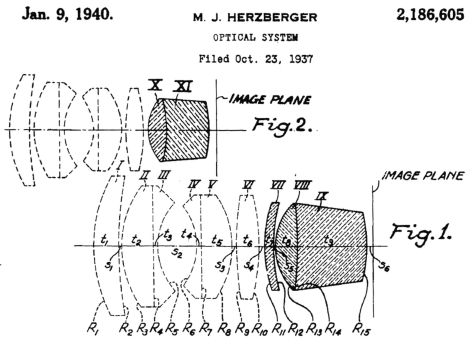
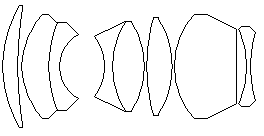
NASA had Zeiss Ikon make lenses for it with an aperture of f/0.7; Stanley Kubrick subsequently had some additional lenses made for him to the same design to use in the filming of the movie Barry Lyndon. A diagram of the optical layout of that lens is shown at right.
The diagram at left is from a patent, filed for in 1937, for a similar lens with a more modest aperture of f/0.813. The part of the lens shown in the diagram in dotted lines is a conventional Double-Gauss lens with a focal length of 100 mm and a maximum aperture of f/2. Behind that is a focal reducer which gives the lens its aperture of f/0.813 by reducing the focal length to 40.65 mm. The principle of using a focal reducer to attain a wider maximum aperture than could be achieved directly is credited to one B. E. Luboshez, from patents dating back to 1929.
One thing, though, that is hard to believe about the Zeiss lens is that the simple six-element Double Gauss portion of the lens on the left has an aperture of f/1.0; one would have expected an f/1.0 lens to have a more elaborate construction. Possibly the focal reducer was used to correct aberrations, and/or very exotic forms of optical glass were used in the lens.
The creator of one web site, however, has looked into the matter, checking what lenses were used in unmanned NASA probes to the Moon, and by astronauts on the Gemini missions, and has reached the conclusion that the lens, while intended originally to be used by an astronaut on one of the Apollo missions, would have ended up not being used for its intended purpose as a consequence of stricter safety rules after the Apollo 1 fire.
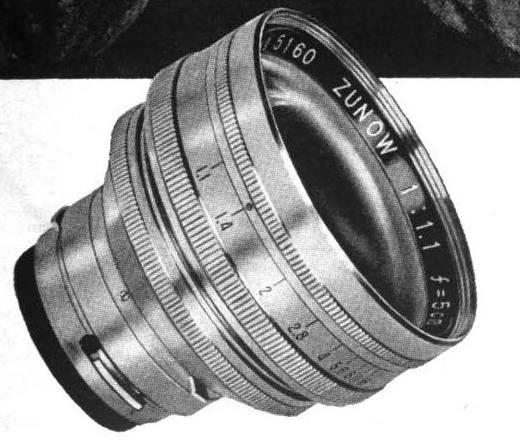
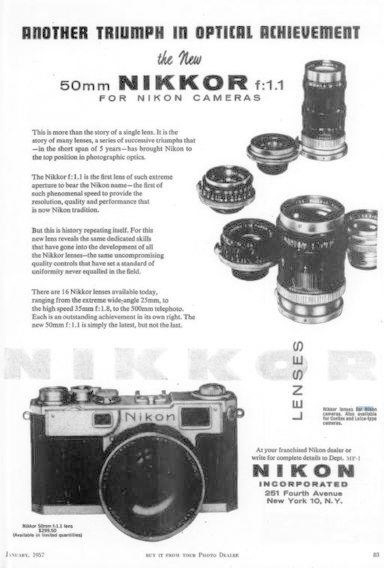
As an indication of where the borderline lies, before Canon's f/0.95 lens became available, in 1956 Zunow was offering a 50mm f/1.1 lens, shown at left, to owners of rangefinder cameras... and a 58mm f/1.2 lens for SLRs, as can be seen from the detail, shown below, from the same advertisement in which the image of the lens for rangefinders shown at left appeared.
And, while Nikon didn't attempt to compete with Canon's f/0.95 lens, they did respond to Zunow's f/1.1 lens with an f/1.1 lens of their own for their rangefinder cameras, an advertisement for which is shown at right.

One does not, however, have to look at historical examples to find the borderline. Instead, where it lies is a simple consequence of the basic laws of optics.
A photographic lens, however many elements it may have, is simply an attempt to approximate the behavior of an ideal thin lens.
It may differ from an ideal thin lens in the location of its principal planes; and, of course, unlike an ideal thin lens, it will have aberrations, however much the design of the lens may have reduced them to a small value.
But other than that, the rays of light entering and leaving the lens will behave nearly as if it was an ideal thin lens. So, in the case of an f/2 lens, for example, since the radius of the aperture is 1/4 of the focal length of the lens, the cone of light to which parallel rays entering the aperture directly along the lens' rotational axis of symmetry will be bent, sending them to the focus, will subtend an angle of twice the arctangent of 0.25, or about 28.725 degrees.
In an SLR camera, the lens can't extend inwards past the flange on which it is mounted by very much, so as to avoid getting in the way of the mirror.
So the diameter of the flange stands in relation to the flange-to-film distance in the same ratio as the maximum permissible aperture diameter to the focal length of the lens to which it applies.
In a rangefinder camera, the flange-to-film distance is much smaller to begin with; as there's no moving mirror in the way, though, there's no reason that the lens couldn't extend through the flange almost right to the film (or sensor) except for the thickness of the focal plane shutter, if any.
Of course, one could cheat... have a lens which also requires one to take the back off of the camera, and put a focal reducer in front of the film... and, presumably, another similar focal reducer below the focusing screen. Then an SLR could have a lens of wider aperture.
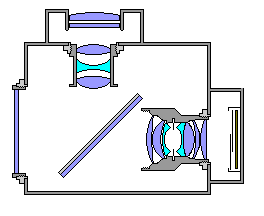
That this is possible can be proven by taking this idea to the extreme; use a flat piece of glass as the "lens" to keep dust out of the camera, and put the actual lens behind the mirror, with another copy below the focusing screen. In effect, one has turned an SLR into a non-reflex camera... or a twin-lens reflex with a bizarre scheme of parallax correction... or a camera of an entirely new basic kind. After all, given that there's no reflex mirror between the viewing screen and the viewfinder lens, it shouldn't be called a reflex camera for the same reason that the Primarette couldn't.
I suppose it could be termed the Single Window Twin Lens Preflex View camera.
The lens opening at the front of the camera now limits the maximum aperture, but not its ratio to the focal length, which could be short enough to allow a very bright focal ratio.
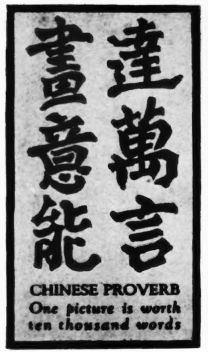
In accordance with the ancient Chinese proverb, "A picture is worth a thousand words", a diagram of the camera configuration here described is added at right. Oh, wait: I just looked it up, and learned that it was made up for an advertisement by one Frederick R. Barnard, and was merely misattributed to the Chinese... in the March 10, 1927 issue of Printer's Ink!
The advertisement there was about an effective advertising campaign; it involved the distribution of "car cards", and the image on the left is how the proverb appeared on those cards. Their purpose was to encourage mothers to bake cakes for their children, or, more specifically, to buy Royal Baking Powder as one of the ingredients with which to make those cakes, and a picture of a happy child enjoying cake was shown to the right of this.
Given that a Chinese translation of the proverb is shown, it's not surprising people would believe it was an actual Chinese proverb.
One does not have to go to such lengths, or the length of making a camera where the reflex mirror is in a removable portion of the camera, to have an SLR that allows the use of lenses that extend close to the film (or sensor). All you need is to be able to lock the reflex mirror in the up position, even when the camera is powered off, in the case of a DSLR, to change lenses. There were film cameras with this feature, and lenses that made use of it, for example Nikon film cameras and some of their early fish-eye lenses.
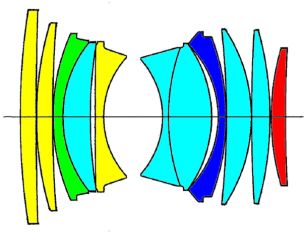
The classic screw mount has a 41mm opening, and a flange-to-film distance of 45.46mm, so the theoretical maximum aperture would be f/1.109; thus, an f/1.1 lens for SLR cameras might exist. In the case of the Canon EF mount, however, the lens opening is 54mm with a flange-to-film distance of 44mm. As a result, in 1989, Canon was able to set a record no one else could equal, let alone surpass, by offering a 50mm lens for its SLR cameras with an f/1.0 focal ratio. A diagram of its optical layout is shown at right. The element highlighted in blue has an aspheric surface and is made of low-dispersion glass; the element highlighted in green only has an aspheric surface, and the elements highlighted in cyan are only made of low-dispersion glass; and the element highlighted in red is a floating element, that is, it moves as the lens is focused to reduce aberrations. Certainly, Nikon, with a 44mm opening and a flange-to-film distance of 46.5mm, in its F mount for their SLRs, could not. However, Miranda cameras aimed at having the widest selection of lenses, so they had a wide 44mm opening, and a relatively small 41.5mm flange-to-film distance; but the ratio is 1.06, as opposed to almost 1.23 for the Canon, so even it would be at a disadvantage.
In order for the screw-mount camera to match Canon, the 42mm screw thread would have to be changed to a 57mm screw thread, to allow for a 56mm opening.
While this was an impressive technical achievement, it took place under unfortunate circumstances. The Canon 50mm f/1.0L USM lens, as it was designated, was introduced along with the Canon EOS-1 camera, which had a new lens mount for autofocus. Two 50mm lenses were initially available in the new series of lenses that it could use: a plain ordinary budget f/1.8 lens, and this f/1.0 lens which was, understandably, quite expensive. It was only a couple of years later that Canon finally gave in to popular demand and brought an f/1.4 lens out again; soon after, the f/1.0 lens was discontinued. Eventually, an f/1.2 lens was made available as a more affordable alternative for people who wanted something faster than f/1.4.
I am sure that many Canon customers, and prospective customers, found such high-handed behavior on the part of the company annoying; some may have been driven to seek out third-party lenses, while others may simply have switched to Nikon given such provocation.
Despite the fact that the flange-to-film distance of a camera for screw-mount lenses is 45.46mm, and the flange-to-film distance of Canon cameras is 44mm, which is less, even with an adapter that moves the screw-mount lens that extra 1.46mm forwards, in the case, at least, of a full-frame Canon DSLR, such as the relatively inexpensive Canon 5D, there is a risk for some screw-mount lenses that when the lens is focused to infinity, the rear elements of the lens will collide with the camera's reflex mirror when taking photographs.
This is why the Pentax K-1 is recommended instead, despite it being a newer and more expensive camera, to those wishing to use M42 screw-mount lenses with a full-frame DSLR.
Another alternative is modifying the mirror in the Canon camera by shaving a little off of the bottom of it, so there is still a budget option. However, while this seems like a safe option, as it would only affect the light going to the viewfinder, not the light going to the camera's sensor... it could interfere with the camera's autofocus and automatic exposure functionality, as that may rely on light going in the direction of the viewfinder instead of the sensor. Investigating the matter in the specific case of the Canon 5D, it appears that the reflex mirror has a central zone that is partially silvered, and another mirror on the back of the reflex mirror reflects light down to the autofocus system. So that would not be affected. But the exposure system is located in the pentaprism, so that would be disturbed by altering the size of the reflex mirror.
Presumably, the cause of the problem is that Canon lenses allow more clearance at the back, and this may have something to do with Canon's use of a breech-lock mount as well - the lenses may have been designed like lenses for other mount types with a flange-to-film distance increased by the thickness of the breech-mount mechanism - essentially because that space is thought of as belonging to the camera.
Of course, the Single Window Twin Lens Preflex View camera, as illustrated above, is a wholly impractical way to address the issue that one feels down in the dumps because the Canon 7 rangefinder camera can have an f/0.95 lens, but your SLR can't.
We've already seen one way to address the issue that can work; just design a camera and lens mounting system so that there is a wide opening to which the lenses attach, and a short flange-to-film distance, so that at least you can make an f/1.0 lens available for your SLR.
But there are other options as well.
The Mamiya Magazine 35 was a rangefinder camera where the back of the camera, in which the film was contained, could be swapped.
Imagine an SLR which doesn't just have a removable pentaprism; also removable is a compartment containing the reflex mirror, with the lens attachment opening in front. And with the option of replacing it with only a flat surface with a lens attachment opening (of a different mount type) so that the camera could switch between being an SLR and a mirrorless camera.
That way one could have a camera that was an SLR most of the time, but which could switch to being mirrorless to allow certain exotic lenses to be used.
I have been able to find the patent for the 50mm f/1.1 lens for rangefinder cameras:
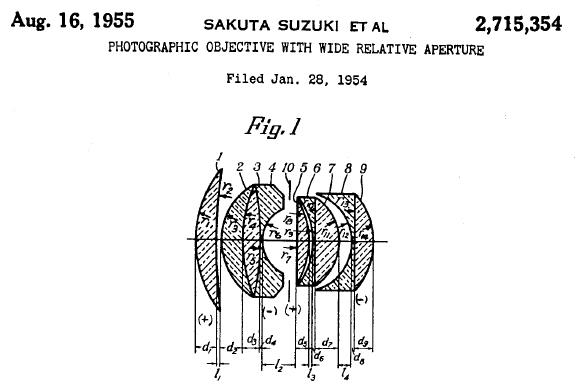
Later, in 1958, Zunow brought out a 35mm SLR camera of its own, called the Zunowflex, and offered the 58mm f/1.2 lens for that camera. Some accounts of this lens online only mention its availability for Zunow's own SLR, and not its previous availability for the popular Exakta camera and for the even more popular screw mount. This is despite the fact that apparently the Zunowflex camera was extremely rare.
I haven't been able, at the moment, to find out information about earlier lenses from Zunow.
However, I have noted other advertisements from 1956; one in which a 75mm f/1.5 Zeiss Biotar is offered for the Exakta camera, and another in which an Angenieux 50mm f/1.5 lens is offered as an option as the normal lens accompanying the purchase of the camera body.
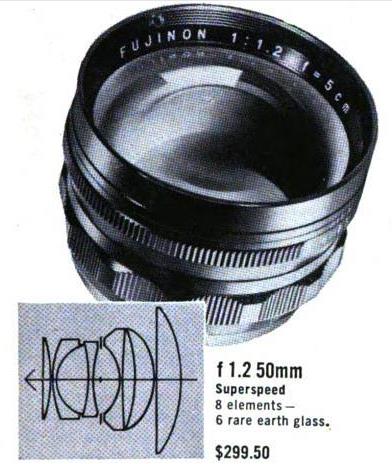
The image above is from 1956, and shows the detailed design of another f/1.2 lens with 50mm focal length, although it may be for rangefinder cameras rather than SLRs.
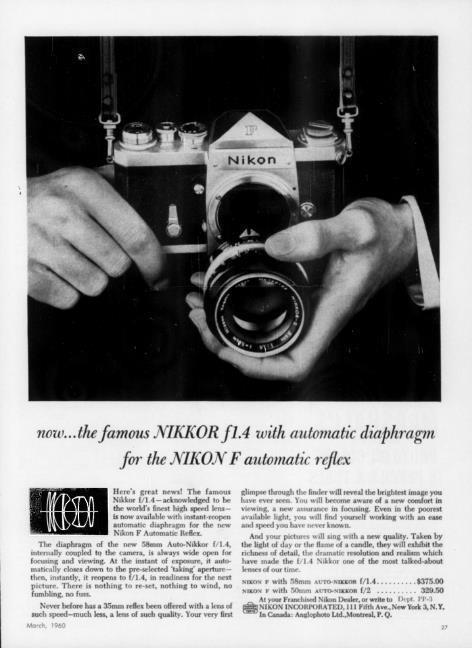
But while you could get an f/1.2 lens for an SLR in 1956, it seems like it wasn't until a few years later that the f/1.4 normal lens became something camera manufacturers routinely included as a high-end option. Thus, the advertisement from 1960 shown at left seems to say that Nikon offering an f/1.4 lens for the Nikon F is something new, not only for them, but a first for the industry (even though the lens is noted as having already been in existence for some time for their rangefinder cameras).
Recently, from elsewhere I've learned that the original rangefinder version of this lens was made possible by the availability of barium flint glass.
That it was possible to design a lens, at least for a camera without the back focus restriction of an SLR, with a focal ratio of f/1.4 was known at least as far back as 1948, because in that year, Kodak was offering their Cine Ektar lens, an f/1.4 lens for 16mm cameras with a 32mm focal length. It had seven elements in four groups. A later f/1.4 Cine Ektar with a 25mm focal length appears to have been more common, however.
As it's not clearly visible due to the reduced size of the advertisement, I will note that the two options for a normal lens to come with the camera being offered are a 50mm f/2 lens, or a 58mm f/1.4 lens, so again, at first the f/1.4 lens was difficult enough to make that a slightly longer focal length was initially needed. (Incidentally, while this advertisement is from 1960, it's noted above that the lens was introduced in 1959.)
Also incidentally, the image of the advertisement at left has been retouched so that the lens diagram for Nikon's new f/1.4 lens that appeared in the ad is clearly visible in the reduced image of the advertisement.
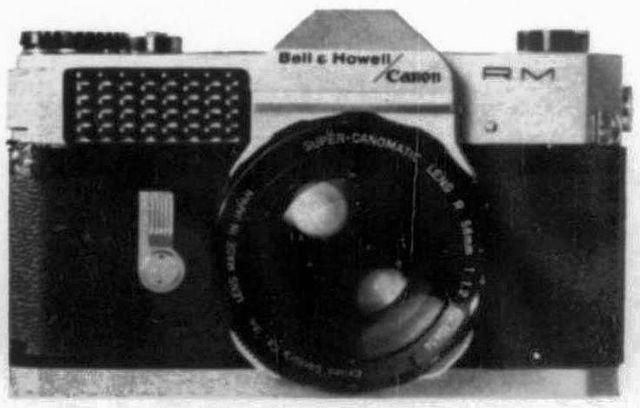
Some other camera makers followed Nikon's example within a few years, while others were in no rush. In 1961, Minolta came out with their 58mm f/1.4 Auto Rokkor, and Zeiss came out with the 55mm f/1.4 Planar for the Contarex; in 1962, Konica had their 52mm f/1.4 Hexanon, and Canon had a 58mm f/1.2 Super-Canomatic lens. Pictured at right is a Canonflex RM camera with this lens. And in 1963, Topcon had their 58mm f/1.4 Auto-Topcon.
It wasn't until 1964 that the Asahi Optical Company came out with the first version of the 50mm f/1.4 Super-Takumar lens for their Pentax cameras; the initial version had eight elements, and some consider it a legend (the same is true of the 58mm Auto-Topcon mentioned above), but after a two-year run it was replaced by a version with the more usual complement of seven elements.
Some of these early high-aperture lenses contain glass which includes thorium oxide, and thus they are slightly radioactive. (In the case of the Pentax 50mm f/1.4 Super-Takumar, the original 8-element 1964 version of the lens was not radioactive, but the same could not be said of the 7-element version that arrived in 1966.)
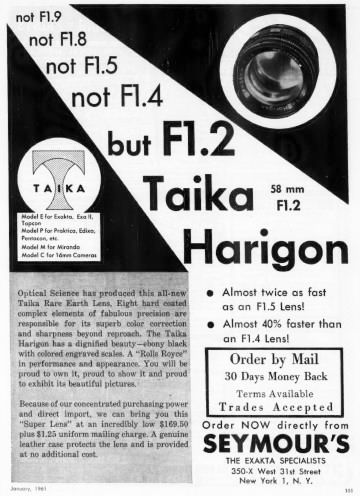
Given the timing of the emergence of the f/1.4 lens as standard equipment, I suppose it shouldn't be too surprising that, as demonstrated by the advertisement shown on the left for the Taika Harigon 58mm f/1.2 lens, that in 1961 an f/1.2 lens was still considered worth making a fuss about; at least if it was available at a low price from a discount retailer.
I've learned, though, that this lens was apparently only available for the Exakta camera - and it mounted to the camera using a secondary mounting system intended for use with unusually large lenses. This means that adapters from the Exakta mount to other mounts won't be usable with this lens. The web site that I learned this from, however, also explained the workaround its author found to make the use of this rare antique lens possible on his camera; it involved transferring the complete mount from an inexpensive non-working Exakta camera to an Exakta mount adapter.
Lenses with a wide aperture allow more light to reach the film, and thus permit the photographer to take pictures without using flash when indoors. This was what made the Ermanox camera such a useful tool, particularly in the hands of Erich Salomon, as noted at the beginning of these pages.
But wider aperture comes at a cost: a narrower depth of field. Pinhole cameras don't even need a lens at all to take pictures in very bright light; as the aperture increases, better and better lenses are required to bring the light to a focus.
When a lens is stopped down to a narrow aperture, such as f/16, while the lens brings the light passing through that aperture to a sharp focus at one point on the film only for objects at a certain distance from the lens, since the cone of light going from the lens to the film is narrow, objects that are at a somewhat different distance will not be very blurry. As the aperture widens, the depth of the field within which objects are in reasonably good focus on the film becomes narrower.
A narrow depth of field, however, isn't always a drawback. It can be used deliberately, by using the widest possible aperture on your lens, and a faster shutter speed than you really need for the shot you are taking, so that the subject of the photograph is in focus, while the background, which is irrelevant, is blurred.
The appearance of out-of-focus areas in a photograph depends on the construction of the lens. One obvious example of this is mirror lenses; these lenses, based on the Maksutov telescope, but usually with additional optical components, have a central obstruction, so each point in a blurred scene expands into a doughnut with a hole in the middle.
Some lenses have been noted as having a particularly pleasing quality to the blurred areas of photographs taken with them. This is referred to as bokeh, which is derived from boke, a Japanese word simply meaning 'blur' or 'haze'.
One lens with a particularly good reputation for this is a 75mm f/1.5 Biotar from Zeiss. As a result, a Chinese firm, TTArtisan, has recently made a modern lens closely patterned after this lens, which it is able to sell at an affordable price, the original being a rare and sought-after collector's item.
The West German portion of Zeiss, Zeiss Ikon, purchased a majority share in Voigtländer in 1956. But the latter company continued to operate independently until 1965, when its operations were more closely integrated with those of Zeiss Ikon itself.
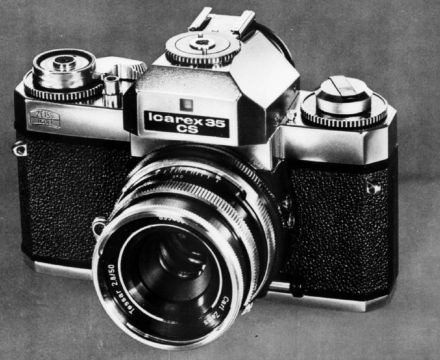
In 1966, the new integrated company of Zeiss Ikon Voigtländer brought out the Icarex 35 camera, the first of the Icarex line of cameras. Another camera from that line, the Icarex 35 CS, is pictured at left.
These cameras offered a number of professional features, such as a removable pentaprism and interchangeable focusing screens, while still being sold at a price comparable to that of ordinary SLR cameras intended for amateur photographers.
The Icarex cameras originally had a bayonet mount for their lenses which was unique to that line of cameras. Several lenses were made for this mount, including the original 36mm to 82mm f/2.8 Zoomar lens first offered for the Bessamatic from Voigtländer.
However, one complaint about the camera was that there weren't any lenses with a particularly wide aperture available for it. This complaint would eventually be resolved by abandoning the proprietary bayonet mount, and changing newer models of the camera over to the widely used M42 screw mount. But before this was done, Zeiss instead attempted to resolve the issue by addressing it directly.
Thus a 50mm f/1.8 lens was developed for Icarex cameras, which first became available in 1968. This lens was the first lens designed at Zeiss with the aid of calculations performed on a computer.
This lens, the Zeiss Ultron, had one other unusual characteristic: the front surface of the lens, the one facing the subject of the photograph, was concave.
In the very early days of photography, cameras often used simple meniscus lenses, and they could as easily face away from the subject as towards the subject. And mirror lenses, as noted above, are based on the Maksutov telescope, and so they often present a concave surface to the subject.
But aside from those two special cases, the Ultron was very nearly unique in having a concave front surface.
This lens is a highly sought-after and expensive collector's item because it also has a very good reputation for the quality of its bokeh. Unlike the Biotar mentioned above, I'm not aware of any modern attempt to imitate it.
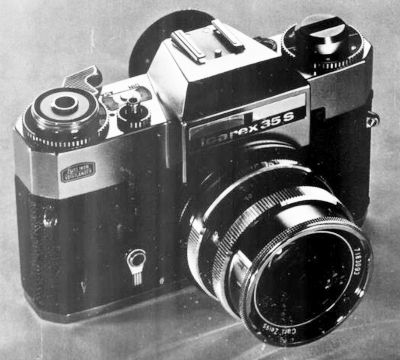
When the Zeiss Ultron lens was first introduced, it was one of the options for a lens to come with the Icarex 35 S camera, introduced at the same time. The image at right of an Icarex 35 S camera appears to show it fitted with a Zeiss Ultron lens.
Some other lenses with a great reputation for the quality of their bokeh include:
However, there are many others. The f/1.4 lenses from Canon and Minolta are also mentioned, the seven-element version of the Super Takumar is not far behind - and the Color Ultron is not far behind the one with the concave front, for example.
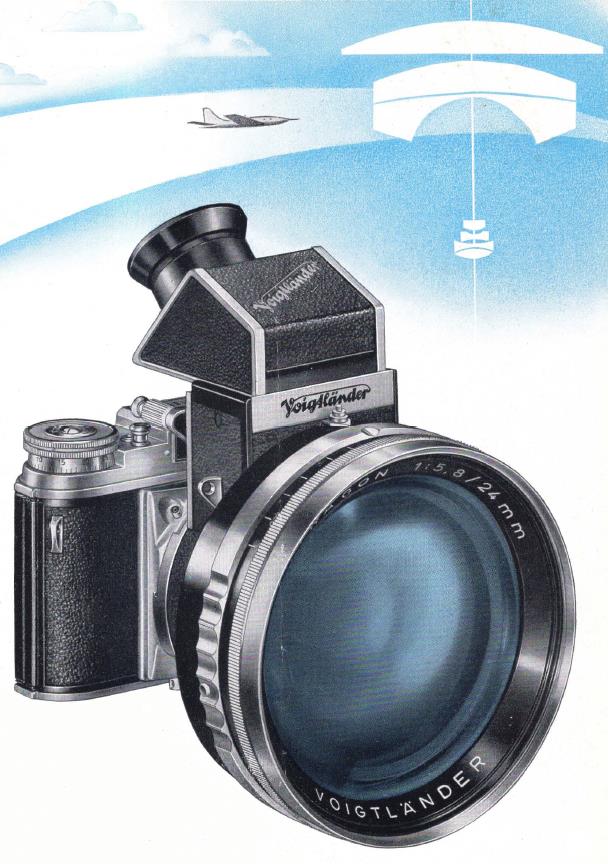
The f/0.95 lens which Canon introduced for its Canon 7 rangefinder camera naturally is strikingly large.
In 1953, Voigtländer offered their Prominent 35mm rangefinder camera. This camera, like the Kodak Retina camera and several other German-made SLR cameras, used leaf shutters in its lenses instead of a focal plane shutter.
Pictured at right is a Voigtländer Prominent camera with a 24mm f/5.8 Ultragon lens fitted. Despite its relatively modest aperture, due to the wide angle of view its short focal length provided, its front elements were also large in size.
A diagram of the optical elements of the Ultragon lens is present in the upper right corner of the image.
On this page, I've spent some time talking about lenses with wide focal ratios that are used to isolate a subject by imposing a narrow depth of field.
But a narrow depth of field is a price paid for having a wide aperture; generally, one would like to have as much of the scene before the camera as possible. Even if one also needs a wide aperture in order to sufficiently expose the film that one has available.
Enter one Stephen E. Garutso, who invented a type of lens that was used on a number of important motion pictures.
His lens was claimed to correct something called vestigial spherical aberration to achieve his results; this claim was likely mistaken.
But the lens did achieve what was claimed for it: making finer detail available in objects at a range of distances of the camera larger than the width of the aperture would normally allow.
How could this be? Wouldn't it violate the laws of optics?
Remember the Petzval lens. This lens had a wider aperture than was really achievable given the optical technology of the time. It achieved this through using astigmatism to counteract curvature of field, so that the lens could focus sharply with a wide aperture... but with reduced contrast for the fine detail in the photograph.
So if you add one or more convex lenses with big holes in them to the front of your camera lens, suddenly part of the light reaching the film is in focus for the distance at which you have focused the camera... and another part is in focus for objects at a closer distance to the camera.
By sacrificing contrast in the fine detail, you have achieved the "impossible", and obtained fine detail for objects over a greater range of distances than is conventionally possible.